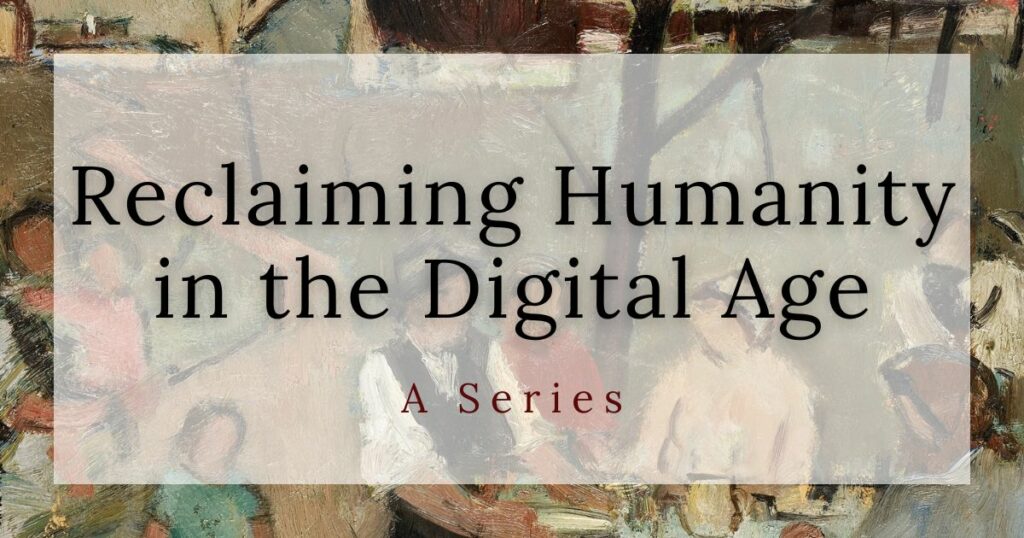This is the third installment in a six-part series, “Reclaiming Humanity in the Digital Age.” Check back for more installments soon.
By Joshua Pauling
Part 1 of this series laid the groundwork for why it’s time to do something about our relationship to screens and digital devices. Part 2 focused on key principles for parenting and family life. In Part 3, we will zoom in on the challenges teens and twenty-somethings face as they are coming of age in the digital world.
Reality Check
A recent New York Times focus group with adolescents provided a glimpse of how growing up in the digital world forms young people.[1] Here are some of the most telling remarks:
- Matthew, 13 years old: “I talk a lot more online that I do in real life.”
- Trinity, 12 years old: “I’m more myself when I’m online. In school I feel like you’re just being watched by teachers. You can’t do as much stuff as you would do at home.”
- Nate, 14 years old: “Online feels more peaceful and calming. You don’t have to talk with anybody in person or do anything in person. You’re just sitting on your bed or chair, watching or doing something.”
- Andrew, 11 years old: “When I’m online, I can mute myself, and they can’t really see me. I can’t just mute myself in real life.”
These frank comments reveal just how easily the digital world normalizes disembodiment and isolation and nudges us towards a disproportionate sense of autonomy. The nudges can be so strong that we begin to prefer digital and online interactions over real life. When we are catechized in the artificial world of digital interfaces, the real world can begin to seem fake and artificial. It becomes intuitive to think we can craft and curate ourselves, however we want, whenever we want, as whoever we want, and that we can craft and curate our communities and relationships, too.
Digital Identity
“I have never felt more myself than I have in this digital body,” said one of the world’s most popular VTubers (video blogger on YouTube) known as “Ironmouse.”[2] Digital bodies offer the opportunity “to be someone else—maybe someone who better aligns with your sense of self.”[3] Rex Woodbury explains why this is more than just a fringe phenomenon: “Millions of people don’t like how they look, much less how they look magnified on a high-resolution screen. And millions more don’t like their ‘boring’ offline lives. These are the catalysts for digital personas: the opportunity to be someone else—maybe someone who better aligns with your sense of self. … Everyone will have a vibrant, three-dimensional digital persona to go alongside their offline identity.”[4]
In a close study of adolescents and college students, the authors of Gen Z Explained conclude that this has become the default way the younger generations conceive of their personal identity: as “fine-grained identities” which are “intricate individual mixes of attributes, the result of careful and ongoing discovery.”[5] Countless apps and social media platforms allow for such granular and tailored identities to be established in parallel by the same person, who attempts to hold them all together. Even what would have been previously understood as conflicting identities are now combined digitally through “molding and assembling various pieces of identity into a coherent whole that gives expression to the inner self.”[6]
Digital Community
Not only is the sense of personal identity changing in the digital environment; the conception and experience of community, relationships, other people, and even the good life are being shaped by the immersive technological habitat as well. “With social media—and the internet more broadly—at their constant and immediate disposal,” say the authors of Gen Z Explained, “postmillennials have the opportunity to fine-tune the communities to which they belong in step with their fine-grained identity.”[7]
The deep desire for belonging is inherent to the human experience. This desire encounters new territory online, as endless access to affinity groups and micro-communities presents itself. As fewer people experience stable family and religious life, other forms of community and belonging fill the void — especially online, where figurative families and communities are assembled and disassembled at will.[8] “Finding your fam is an ongoing project that need not be set in stone,” a college student explains, “even if you don’t get it right—you find out your identity one way and you switch to another. It does not matter. It is not something that is meant to be fixed. It’s fluid.”[9]
What To Do About It
Young people are trying to make meaning and find community amid the digital world they find themselves in. They are, according to Gen Z Explained, trying to “balance flexibility with stability, and freedom with security, in this quest for belonging that matches their identity. Just as fluidity and flexibility are central to many aspects of their personal identities, so too with the groups to which they belong. Their art of digital living involves joining and leaving groups as identities become clearer and habits of being change.”[10]
Many teenagers (and children and adults too!) spend a majority of their waking hours engaged with some sort of screen.[11] Is it any surprise that internet life seems to be more real than real life? Is it any surprise that identity and community become commodities and exercises of personal expression and choice? Is it any surprise that flesh and blood interactions with real people and real things come to be seen as interruptions or inconveniences between the dopamine hits of the internet?
What we have here is much bigger than a “kids these days” problem. Our internet-connected devices and the apps and platforms we use are reshaping us and our world, hacking our attention, and playing on our worst instincts. In some cases, they are purposely designed to get us addicted.[12] The pattern of addictive behaviors common with substance abuse is evident when our brains get rewired to seek the pleasure jolts of the online world, like the addict’s brain seeks increasing hits of their drug of choice.[13]
In the already tumultuous time of puberty and adolescence, these are the last things young people need. All of this is more than our shoulders are designed to bear. The intense focus on continual self-discovery and exploration provides no sure anchor from which one can live with purpose. Instead, it pushes us towards a gnostic-like disembodiment, a rejection of the limitations of bodily existence, and a frenetic ongoing search for the true self. All of these work at cross-purposes to human flourishing.
Instead, we can:
1. Embrace Our God-Given Identity
As young people come of age, they need — as we all do — the surety and stability of an identity given by God. Our true human identity is a given identity. At our birth, our name is given, our place is given, our family is given, our community is given — all from the hand of our gracious Father (Luke 11:1–12; James 1:17). So, perhaps it’s time to choose not to choose our identities and instead receive our identity. We can be rooted, settled selves by receiving the gifts of our identity, for we are not our own; we were bought with a price (1 Cor. 6:19–20). There are enough unknowns in the universe. We don’t need to upend the most fundamental and primal forms of human identity by turning them into additional questions of self-discovery.
2. Embrace Our God-Given Community
Our God-given identity places us within webs of mutual support and reciprocal love. In the digital age, this is especially powerful. It models an alternative way of being, one that reconnects us to our humanity in at least two ways. First, it highlights our relational nature by strengthening the bonds of communal love. Second, it accents our embodied nature by following the pattern of Christ Himself who took on flesh and will always have His body. The church is not a self-chosen, niche community of people who share all the same affinities and interests. It is a family, real and messy, with plumbers and doctors, Democrats and Republicans, musicians and engineers, valedictorians and dropouts, handicapped people and athletes, all gathered around the same Christ to hear and receive from Him. And that reception of His gifts of love by faith then flows out in love and service of one another.
You’re Not Alone
This is not a finger-pointing, hand-waving exercise. It is an acknowledgement that we have a problem that goes much deeper than will-power or discipline, or older generations criticizing younger generations. The problem crosses generational lines and requires all of us to work together to rediscover the joys and challenges of embodied life with one another. And that is exactly what young and old alike crave. So, encourage those young people who have ditched their smartphone for a flip phone.[14] Applaud those Gen Z-ers and college students who have seen the detrimental effects of online living and have taken a pledge of “appstinence” to forego social media and focus on real-world connections and relationships.[15] And consider joining them! Invite them over for lunch or out for coffee. Send them a hand-written note while they’re away at college. Break bread together. Sweat together in shared projects for the good of the church and the community. For it is in such simple things that we are reawakened to who we really are: creatures made by God with a body and soul, designed for communion with God and with one another.
In Part 4, we will turn to how the life of adults has changed in the digital age.
[1] Adrian J. Rivera and Ariel Kaminer, “‘Listen to Us.’ What These 12 Kids Want Adults to Know,” The New York Times, March 21, 2023, https://www.nytimes.com/interactive/2023/03/21/opinion/teen-youth-focus-group.html.
[2] Ironmouse, cited in Rex Woodbury, “Transhuman: The Rise of Digital Identities,” Digital Native Substack, May 26, 2021, https://digitalnative.substack.com/p/transhuman-the-rise-of-digital-identities.
[3] Woodbury, “Transhuman.”
[4] Woodbury, “Transhuman.”
[5] Roberta Katz, Sarah Ogilvie, Jane Shaw, and Linda Woodhead, Gen Z Explained: The Art of Living in a Digital Age, (IL: University of Chicago Press, 2021) 39.
[6] Katz, et. al, Gen Z Explained, 68.
[7] Katz, et. al, Gen Z Explained, 94.
[8] Mary Eberstadt explains how in such an atmosphere of familial and religious decline, people of all stripes and on all sides are yearning for a tribe, and many hope to find “figurative family/community to do what literal families/communities of earlier times did by default.” Mary Eberstadt, Primal Screams (Templeton Press, 2019) 11, 69.
[9] Katz, et. al, Gen Z Explained, 94, 202.
[10] Katz, et. al, Gen Z Explained, 94.
[11] The exact numbers vary somewhat, but most are in the 8+ hours per day range. Then, when you consider that many schools now are more reliant on screens in their instructional methods and practices, the numbers look even worse. To the point where Jonathan Haidt concludes that many teens are “almost constantly” interacting with a screen of some sort at astounding rates of “16 hours per day—112 hours per week.” Haidt explains that “this kind of continuous use, often involving two or three screens at a time, was simply not possible before kids carried touch screens in their pockets. It has enormous implications for cognition, addiction, and the wearing smooth of paths in the brain, especially during the sensitive period of puberty.” Jonathan Haidt, The Anxious Generation: How the Great Rewiring of Childhood Is Causing an Epidemic of Mental Illness (NY: Penguin Press, 2024), 119-120.
[12] Ted Gioia, “What’s Happening to Students?” The Honest Broker Substack, Mar 21, 2025, https://www.honest-broker.com/p/whats-happening-to-students
[13] Anna Lembke, Dopamine Nation: Finding Balance in the Age of Indulgence (NY: Dutton, 2021); Ted Gioia, “The State of the Culture, 2024,” The Honest Broker Substack, Feb 18, 2024, https://www.honest-broker.com/p/the-state-of-the-culture-2024.
[14] Edward Hoke, “Why I Flipped Phones in College. And Why I’m Never Going Back,” Thrive Global, Sept 4, 2018, https://community.thriveglobal.com/why-i-have-a-flip-phone; Mason Edwards, “Digital Detox: Students Embrace Flip Phones on Campus,” University Echo, Oct 14, 2023, https://www.theutcecho.com/features/digital-detox-students-embrace-flip-phones-on-campus/article_6244537c-6705-11ee-b6b7-7744b7cb2435.html; Amy Kawata, “The Return of Dumb Phones? Teens Ditch Easy Internet Access for Mental Health,” CBS News, May 31, 2023, https://www.cbsnews.com/baltimore/news/the-return-of-dumb-phones-teens-ditch-easy-internet-access-for-mental-health/.
[15] Kaitlyn Reilly, “Preferring to Live Life Offline, These Young People Are Practicing ‘Appstinence,’” Yahoo Life, March 24, 2025, https://www.yahoo.com/lifestyle/preferring-live-life-offline-young-113059369.html.





